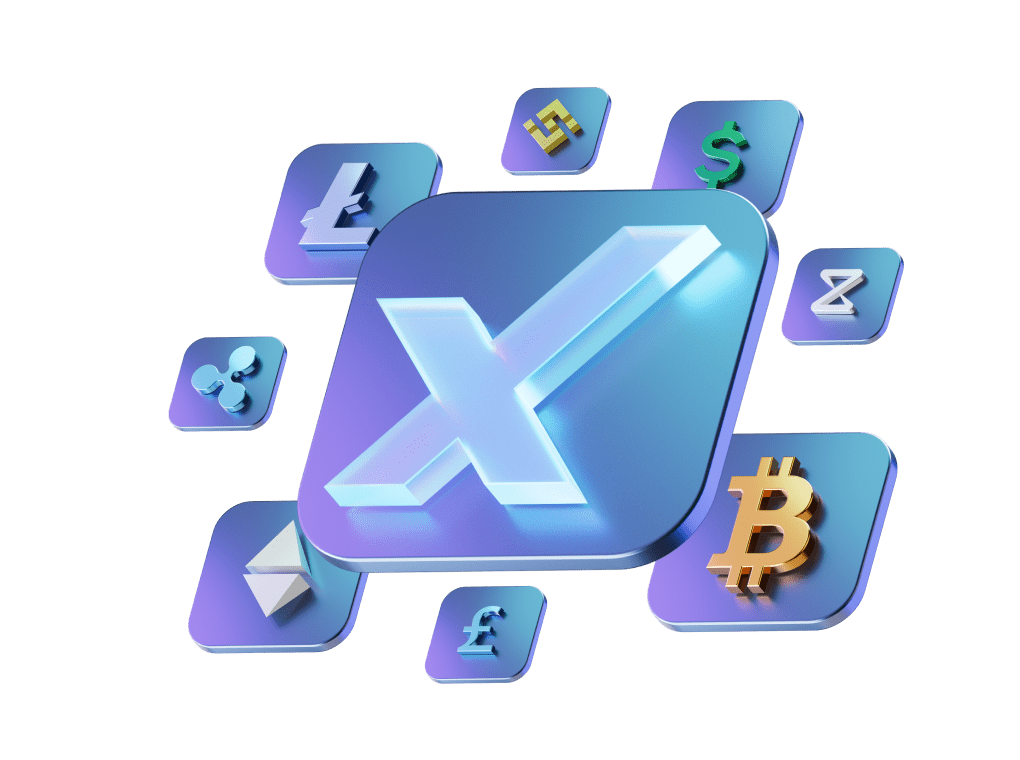
- Espanol Choose language
- Portuguese Choose language
- Turkish Choose language
- Hindi Choose language
- Italian Choose language
- French Choose language
- Tagalog Choose language
- Thai Choose language
- Vietnamese Choose language
- Polish Choose language
- Malay Choose language
- Indonesian Choose language
- Taiwanese Choose language
- Uzbek Choose language
- Kyrgyz Choose language
Search

What Is a Crypto Exchange?
From trading Bitcoin to accessing decentralized finance (DeFi), crypto exchanges are the foundation of the digital asset economy. In this guide, you’ll discover what crypto exchanges do, how they work, the differences between centralized and decentralized models, what to consider when choosing one, and why XBO’s platform offers a next-generation experience - whether you’re new to crypto or ready to take the next step. XBO is a regulated crypto exchange designed for simplicity, security, and speed. It’s trusted by both first-time investors and experienced traders for its intuitive interface, transparent pricing, and real-time support - everything you need to make confident decisions in a fast-moving market.


What Does a Crypto Exchange Do?
A crypto exchange is a digital platform where users can buy, sell, and trade cryptocurrencies like Bitcoin (BTC), Ethereum (ETH), and hundreds of altcoins.
Just like a traditional stock exchange facilitates the buying and selling of company shares, a crypto exchange:
- Matches buyers and sellers using a trading engine
- Lists real-time prices and charts for every asset pair
- Manages custodial or non-custodial wallets, depending on the platform type
- Enables fiat onramps and offramps (e.g., USD → BTC or BTC → EUR)
- Provides trading infrastructure for spot, margin, and sometimes derivatives markets
- Implements KYC/AML verification to meet legal standards (on CEXs)
- Maintains order books and ensures liquidity for listed assets
Some exchanges also support staking rewards, DeFi integration, and on-chain analytics tools to help users make informed decisions. These features often help traders better time their entries, identify trends, and diversify their crypto strategies.

How Crypto Exchanges Work
Crypto exchanges use order books to match buy and sell offers in real-time. Liquidity refers to how easily assets can be bought or sold without causing large price movements.
Many centralized exchanges (CEXs) partner with market makers — entities that continuously provide buy and sell orders—to ensure trades are always available.
Other key components that influence liquidity and execution speed include:
-
1
Matching engines
Software that processes thousands of trades per second
-
2
Liquidity pools
Especially on DEXs or hybrid platforms
-
3
Slippage control
Tools to manage price impact during order execution
Liquidity is critical—especially during high-volatility events—so always choose an exchange with deep order books.

Centralized vs. Decentralized Exchanges (CEX vs. DEX)
There are two major types of crypto exchanges: centralized (CEX) and decentralized (DEX). Some newer platforms also fall into a hybrid category, combining centralized onboarding with decentralized custody or trading (e.g., dYdX).
In short:
-
CEXs
like XBO are ideal for users who value ease, speed, and access to fiat deposits/withdrawals.
-
DEXs
are better suited for privacy-focused or DeFi-native users.

How Crypto Exchanges Work (Step-by-Step)
User
CRYPTO EXCHANGE
User
Let’s walk through a typical user journey using an example:
Alice is new to crypto. She signs up for XBO, completes verification, deposits $500 via bank transfer, and places an order to buy $250 worth of Ethereum. Within seconds, her order executes, and she sees ETH in her portfolio. A week later, she withdraws it to her hardware wallet.
Most CEXs, including XBO, follow this basic process:
-
1
Sign Up & Verify
Create an account and complete KYC (Know Your Customer) verification.
-
2
Deposit Funds
Transfer fiat (e.g., USD) or crypto to your exchange wallet.
-
3
Place an Order
Choose a market or limit order to buy/sell your desired crypto.
-
4
Trade Execution
The platform matches your order in real-time using an order book.
-
5
Withdraw
Move your funds to your personal wallet or bank account.
Behind the scenes, exchanges rely on complex matching engines, deep liquidity pools, and sometimes market makers to ensure trades are filled quickly and fairly. XBO's infrastructure is optimized for reliability and high throughput.

Order Types Explained
When trading on a crypto exchange, you’ll typically choose between three common order types:
Market Order
Buys or sells immediately at the current best available price
Stop Order
Triggers a buy or sell when a certain price is reached (often used for risk management)
Limit Order
Sets a specific price—you only trade if the market hits it
Understanding which order to use can help reduce fees, avoid slippage, and improve trading outcomes. Most beginner-friendly exchanges like XBO allow you to toggle between these types easily within the trade interface.

What to Look for in a Crypto Exchange
Choosing the right exchange is essential to ensure your funds are secure, trades are efficient, and the platform suits your experience level.
- Security: Cold storage, 2FA, and platform audits
- Fees: Transparent fee tiers and how they compare
- User Experience: Tools, education, and UI design
- Asset Range & Liquidity: Especially during volatile markets
- Support & Regulation: For confidence and protection

Why Choose XBO’s Crypto Exchange?
XBO is designed for users who want a streamlined, high-performance crypto experience with full regulatory confidence. Here’s what makes it stand out:
Advanced Security Stack
Includes cold storage for >95% of assets, account activity alerts, and AI-driven fraud detection.
Fiat Flexibility
Supports deposits in multiple fiat currencies and withdrawal options, including local bank rails.
Real-Time Trading Engine
Built for speed and uptime, capable of processing thousands of orders per second.
Unified Wallet Management
Hold, stake, and transfer assets from one dashboard.
Global Compliance
Licensed and regulated in multiple jurisdictions for a compliant, border-friendly experience.
Mobile-First Design
Optimized trading for Android and iOS with native biometric login.
Community and Learning
Offers educational modules and a growing knowledge base for beginner-to-advanced traders.
Transparent Pricing
No hidden fees, with fee tiers clearly visible before order confirmation.
Live Support with Human Agents
Connect to real people for help with verification, deposits, or trading—no bots required.
Whether you're new to crypto or looking to upgrade your trading platform, XBO delivers performance, protection, and simplicity in one place.

Frequently Asked Questions
-
Is a crypto exchange the same as a crypto wallet?
No. A crypto exchange lets you trade cryptocurrencies, while a crypto wallet is a secure place to store them. Some exchanges provide built-in wallets, but for long-term storage, external wallets are recommended. -
Can I buy crypto with fiat currency on XBO?
Yes. XBO supports fiat deposits via bank transfer and credit/debit cards, allowing users to purchase crypto with local currencies. -
Is it safe to leave my crypto on an exchange?
Exchanges like XBO use advanced security, but best practice is to withdraw long-term holdings to a personal wallet. Use XBO for trading and quick access. -
What’s the difference between spot and margin trading?
Spot trading involves buying crypto directly, while margin trading uses borrowed funds to amplify potential gains (and risks). -
Do I need an account to use a crypto exchange?
Yes, most centralized exchanges like XBO require you to open an account and complete KYC before trading.
The material presented in this website are for general information purposes only and are not investment advice or a recommendation or solicitation to buy, sell, stake or hold any cryptoasset or to engage in any specific trading strategy. The volatile and unpredictable nature of the crypto-asset markets can lead to loss of funds. Geographic restrictions may also apply. This information is not directed or intended for distribution to or use by residents of certain countries/jurisdictions, including, but not limited to USA, China, Iran, Russia and more, since the Company does not offer its services to any of these jurisdictions.
Digital assets are complex instruments and involve high risk. Please ensure that you fully understand the risks involved before entering into any transactions.
Contact us: [email protected]
PROCRYPTIC SP. Z O.O., registered address at Mennica Legacy Tower, Prosta 20, 00-850 Warsaw, Poland.CLICKJOINT B.V., registered address at Zuikertuintjeweg Z/N (Zulkertuin Tower) Curacao.
